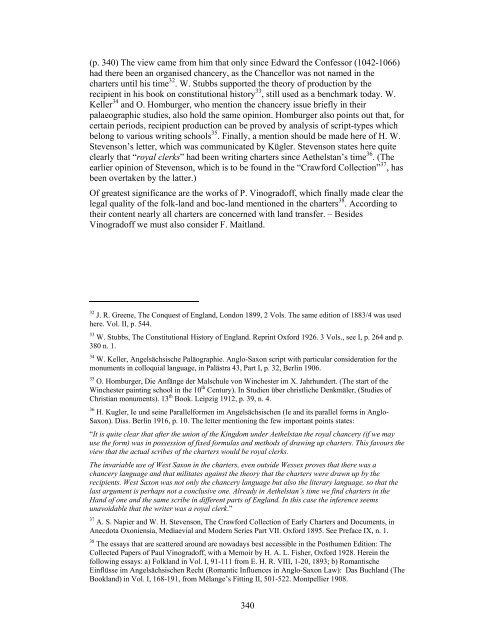Provisional Drogereit pdf
Provisional Drogereit pdf
Provisional Drogereit pdf
Create successful ePaper yourself
Turn your PDF publications into a flip-book with our unique Google optimized e-Paper software.
(p. 340) The view came from him that only since Edward the Confessor (1042-1066)<br />
had there been an organised chancery, as the Chancellor was not named in the<br />
charters until his time 32 . W. Stubbs supported the theory of production by the<br />
recipient in his book on constitutional history 33 , still used as a benchmark today. W.<br />
Keller 34 and O. Homburger, who mention the chancery issue briefly in their<br />
palaeographic studies, also hold the same opinion. Homburger also points out that, for<br />
certain periods, recipient production can be proved by analysis of script-types which<br />
belong to various writing schools 35 . Finally, a mention should be made here of H. W.<br />
Stevenson’s letter, which was communicated by Kügler. Stevenson states here quite<br />
clearly that “royal clerks” had been writing charters since Aethelstan’s time 36 . (The<br />
earlier opinion of Stevenson, which is to be found in the “Crawford Collection” 37 , has<br />
been overtaken by the latter.)<br />
Of greatest significance are the works of P. Vinogradoff, which finally made clear the<br />
legal quality of the folk-land and boc-land mentioned in the charters 38 . According to<br />
their content nearly all charters are concerned with land transfer. – Besides<br />
Vinogradoff we must also consider F. Maitland.<br />
32<br />
J. R. Greene, The Conquest of England, London 1899, 2 Vols. The same edition of 1883/4 was used<br />
here. Vol. II, p. 544.<br />
33<br />
W. Stubbs, The Constitutional History of England. Reprint Oxford 1926. 3 Vols., see I, p. 264 and p.<br />
380 n. 1.<br />
34 W. Keller, Angelsächsische Paläographie. Anglo-Saxon script with particular consideration for the<br />
monuments in colloquial language, in Palästra 43, Part I, p. 32, Berlin 1906.<br />
35 O. Homburger, Die Anfänge der Malschule von Winchester im X. Jahrhundert. (The start of the<br />
Winchester painting school in the 10 th Century). In Studien über christliche Denkmäler, (Studies of<br />
Christian monuments). 13 th Book. Leipzig 1912, p. 39, n. 4.<br />
36<br />
H. Kugler, Ie und seine Parallelformen im Angelsächsischen (Ie and its parallel forms in Anglo-<br />
Saxon). Diss. Berlin 1916, p. 10. The letter mentioning the few important points states:<br />
“It is quite clear that after the union of the Kingdom under Aethelstan the royal chancery (if we may<br />
use the form) was in possession of fixed formulas and methods of drawing up charters. This favours the<br />
view that the actual scribes of the charters would be royal clerks.<br />
The invariable use of West Saxon in the charters, even outside Wessex proves that there was a<br />
chancery language and that militates against the theory that the charters were drawn up by the<br />
recipients. West Saxon was not only the chancery language but also the literary language, so that the<br />
last argument is perhaps not a conclusive one. Already in Aethelstan’s time we find charters in the<br />
Hand of one and the same scribe in different parts of England. In this case the inference seems<br />
unavoidable that the writer was a royal clerk.”<br />
37 A. S. Napier and W. H. Stevenson, The Crawford Collection of Early Charters and Documents, in<br />
Anecdota Oxoniensia, Mediaevial and Modern Series Part VII. Oxford 1895. See Preface IX, n. 1.<br />
38 The essays that are scattered around are nowadays best accessible in the Posthumen Edition: The<br />
Collected Papers of Paul Vinogradoff, with a Memoir by H. A. L. Fisher, Oxford 1928. Herein the<br />
following essays: a) Folkland in Vol. I, 91-111 from E. H. R. VIII, 1-20, 1893; b) Romantische<br />
Einflüsse im Angelsächsischen Recht (Romantic Influences in Anglo-Saxon Law): Das Buchland (The<br />
Bookland) in Vol. I, 168-191, from Mélange’s Fitting II, 501-522. Montpellier 1908.<br />
340
















